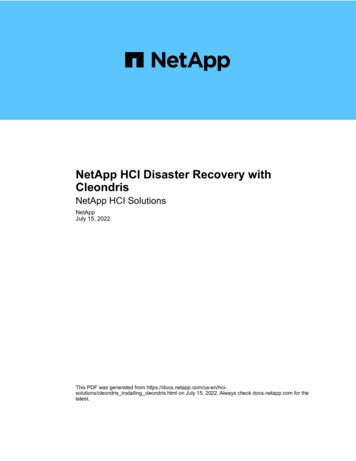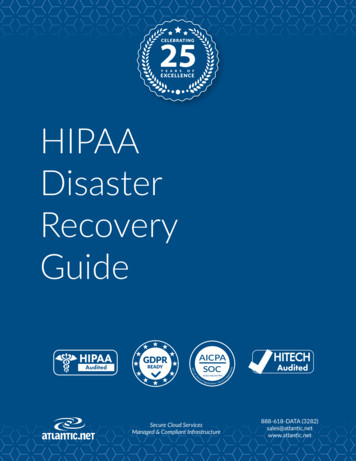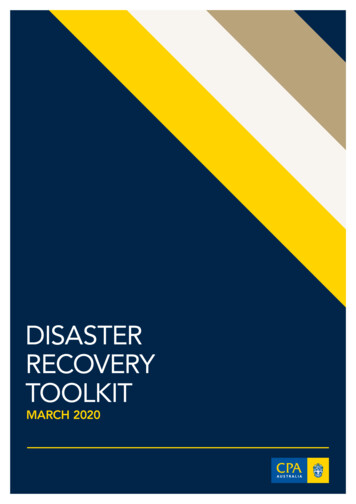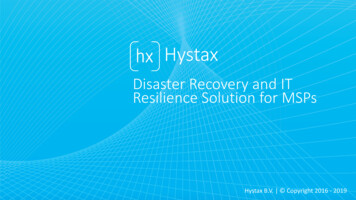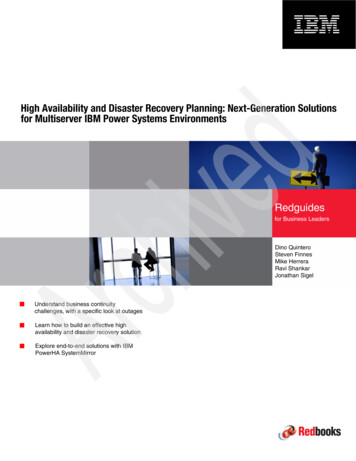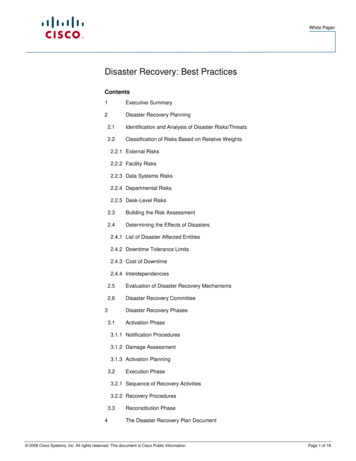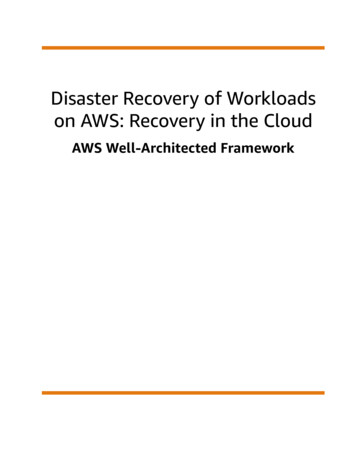
Transcription
Disaster Recovery of Workloadson AWS: Recovery in the CloudAWS Well-Architected Framework
Disaster Recovery of Workloads on AWS: Recoveryin the Cloud AWS Well-Architected FrameworkDisaster Recovery of Workloads on AWS: Recovery in the Cloud: AWSWell-Architected FrameworkCopyright Amazon Web Services, Inc. and/or its affiliates. All rights reserved.Amazon's trademarks and trade dress may not be used in connection with any product or service that is notAmazon's, in any manner that is likely to cause confusion among customers, or in any manner that disparages ordiscredits Amazon. All other trademarks not owned by Amazon are the property of their respective owners, who mayor may not be affiliated with, connected to, or sponsored by Amazon.
Disaster Recovery of Workloads on AWS: Recoveryin the Cloud AWS Well-Architected FrameworkTable of ContentsAbstract . 1Introduction . 2Disaster recovery and availability . 2Are you Well-Architected? . 3Shared Responsibility Model for Resiliency . 4AWS responsibility “Resiliency of the Cloud” . 4Customer responsibility “Resiliency in the Cloud” . 4What is a disaster? . 6High availability is not disaster recovery . 7Business Continuity Plan (BCP) . 8Business impact analysis and risk assessment . 8Recovery objectives (RTO and RPO) . 8Disaster recovery is different in the cloud . 11Single AWS Region . 11Multiple AWS Regions . 12Disaster recovery options in the cloud . 13Backup and restore . 13AWS services . 14Pilot light . 16AWS services . 17AWS Elastic Disaster Recovery . 19Warm standby . 19AWS services . 20Multi-site active/active . 21AWS services . 21Detection . 23Testing disaster recovery . 24Conclusion . 25Contributors . 26Further reading . 27Document history . 28Notices . 29AWS glossary . 30iii
Disaster Recovery of Workloads on AWS: Recoveryin the Cloud AWS Well-Architected FrameworkDisaster Recovery of Workloads onAWS: Recovery in the CloudPublication date: February 12, 2021 (Document history (p. 28))Disaster recovery is the process of preparing for and recovering from a disaster. An event that prevents aworkload or system from fulfilling its business objectives in its primary deployed location is considereda disaster. This paper outlines the best practices for planning and testing disaster recovery for anyworkload deployed to AWS, and offers different approaches to mitigate risks and meet the RecoveryTime Objective (RTO) and Recovery Point Objective (RPO) for that workload.1
Disaster Recovery of Workloads on AWS: Recoveryin the Cloud AWS Well-Architected FrameworkDisaster recovery and availabilityIntroductionYour workload must perform its intended function correctly and consistently. To achieve this, you mustarchitect for resiliency. Resiliency is the ability of a workload to recover from infrastructure, service,or application disruptions, dynamically acquire computing resources to meet demand, and mitigatedisruptions, such as misconfigurations or transient network issues.Disaster recovery (DR) is an important part of your resiliency strategy and concerns how your workloadresponds when a disaster strikes (a disaster (p. 6) is an event that causes a serious negative impacton your business). This response must be based on your organization's business objectives whichspecify your workload's strategy for avoiding loss of data, known as the Recovery Point Objective(RPO) (p. 8), and reducing downtime where your workload is not available for use, known as theRecovery Time Objective (RTO) (p. 8). You must therefore implement resilience in the design of yourworkloads in the cloud to meet your recovery objectives (RPO and RTO (p. 8)) for a given one-timedisaster event. This approach helps your organization to maintain business continuity as part of BusinessContinuity Planning (BCP) (p. 8).This paper focuses on how to plan for, design, and implement architectures on AWS that meet thedisaster recovery objectives for your business. The information shared here is intended for those intechnology roles, such as chief technology officers (CTOs), architects, developers, operations teammembers, and those tasked with assessing and mitigating risks.Disaster recovery and availabilityDisaster recovery can be compared to availability, which is another important component of yourresiliency strategy. Whereas disaster recovery measures objectives for one-time events, availabilityobjectives measure mean values over a period of time.2
Disaster Recovery of Workloads on AWS: Recoveryin the Cloud AWS Well-Architected FrameworkAre you Well-Architected?Figure 1 - Resiliency ObjectivesAvailability is calculated using Mean Time Between Failures (MTBF) and Mean Time to Recover (MTTR):This approach is often referred to as “nines”, where a 99.9% availability target is referred to as “threenines”.For your workload, it may be easier to count successful and failed requests instead of using a time-basedapproach. In this case, the following calculation can be used:Disaster recovery focuses on disaster events, whereas availability focuses on more common disruptionsof smaller scale such as component failures, network issues, software bugs, and load spikes. Theobjective of disaster recovery is business continuity, whereas availability concerns maximizing the timethat a workload is available to perform its intended business functionality. Both should be part of yourresiliency strategy.Are you Well-Architected?The AWS Well-Architected Framework helps you understand the pros and cons of the decisions you makewhen building systems in the cloud. The six pillars of the Framework allow you to learn architectural bestpractices for designing and operating reliable, secure, efficient, cost-effective, and sustainable systems.Using the AWS Well-Architected Tool, available at no charge in the AWS Management Console, you canreview your workloads against these best practices by answering a set of questions for each pillar.The concepts covered in this whitepaper expand on the best practices contained in the ReliabilityPillar whitepaper, specifically question REL 13, “How do you plan for disaster recovery (DR)?”. Afterimplementing the practices in this whitepaper, be sure to review (or re-review) your workload using theAWS Well-Architected Tool.3
Disaster Recovery of Workloads on AWS: Recoveryin the Cloud AWS Well-Architected FrameworkAWS responsibility “Resiliency of the Cloud”Shared Responsibility Model forResiliencyResiliency is a shared responsibility between AWS and you, the customer. It is important that youunderstand how disaster recovery and availability, as part of resiliency, operate under this shared model.AWS responsibility “Resiliency of the Cloud”AWS is responsible for resiliency of the infrastructure that runs all of the services offered in the AWSCloud. This infrastructure comprises the hardware, software, networking, and facilities that run AWSCloud services. AWS uses commercially reasonable efforts to make these AWS Cloud services available,ensuring service availability meets or exceeds AWS Service Level Agreements (SLAs).The AWS Global Cloud Infrastructure is designed to enable customers to build highly resilient workloadarchitectures. Each AWS Region is fully isolated and consists of multiple Availability Zones, whichare physically isolated partitions of infrastructure. Availability Zones isolate faults that could impactworkload resilience, preventing them from impacting other zones in the Region. But at the same time,all zones in an AWS Region are interconnected with high-bandwidth, low-latency networking, over fullyredundant, dedicated metro fiber providing high-throughput, low-latency networking between zones.All traffic between zones is encrypted. The network performance is sufficient to accomplish synchronousreplication between zones. When an application is partitioned across AZs, companies are better isolatedand protected from issues such as power outages, lightning strikes, tornadoes, hurricanes, and more.Customer responsibility “Resiliency in the Cloud”Your responsibility will be determined by the AWS Cloud services that you select. This determines theamount of configuration work you must perform as part of your resiliency responsibilities. For example, aservice such as Amazon Elastic Compute Cloud (Amazon EC2) requires the customer to perform all of thenecessary resiliency configuration and management tasks. Customers that deploy Amazon EC2 instancesare responsible for deploying EC2 instances across multiple locations (such as AWS Availability Zones),implementing self-healing using services like AWS Auto Scaling , as well as using resilient workloadarchitecture best practices for applications installed on the instances. For managed services, such asAmazon S3 and Amazon DynamoDB, AWS operates the infrastructure layer, the operating system,and platforms, and customers access the endpoints to store and retrieve data. You are responsible formanaging resiliency of your data including backup, versioning, and replication strategies.Deploying your workload across multiple Availability Zones in an AWS Region is part of a high availabilitystrategy designed to protect workloads by isolating issues to one Availability Zone, and uses theredundancy of the other Availability Zones to continue serving requests. A Multi-AZ architecture is alsopart of a DR strategy designed to make workloads better isolated and protected from issues such aspower outages, lightning strikes, tornadoes, earthquakes, and more. DR strategies may also make use ofmultiple AWS Regions. For example in an active/passive configuration, service for the workload will failover from its active region to its DR region if the active Region can no longer serve requests.4
Disaster Recovery of Workloads on AWS: Recoveryin the Cloud AWS Well-Architected FrameworkCustomer responsibility “Resiliency in the Cloud”Figure 2 - Resiliency is a shared responsibility between AWS and the customer5
Disaster Recovery of Workloads on AWS: Recoveryin the Cloud AWS Well-Architected FrameworkWhat is a disaster?When planning for disaster recovery, evaluate your plan for these three main categories of disaster: Natural disasters, such as earthquakes or floods Technical failures, such as power failure or network connectivity Human actions, such as inadvertent misconfiguration or unauthorized/outside party access ormodificationEach of these potential disasters will also have a geographical impact that can be local, regional,country-wide, continental, or global. Both the nature of the disaster and the geographical impact areimportant when considering your disaster recovery strategy. For example, you can mitigate a localflooding issue causing a data center outage by employing a Multi-AZ strategy, since it would not affectmore than one Availability Zone. However, an attack on production data would require you to invoke adisaster recovery strategy that fails over to backup data in another AWS Region.6
Disaster Recovery of Workloads on AWS: Recoveryin the Cloud AWS Well-Architected FrameworkHigh availability is not disasterrecoveryBoth availability and disaster recovery rely on some of the same best practices, such as monitoringfor failures, deploying to multiple locations, and automatic failover. However, Availability focuseson components of the workload, whereas disaster recovery focuses on discrete copies of the entireworkload. Disaster recovery has different objectives from Availability, measuring time to recovery afterthe larger scale events that qualify as disasters. You should first ensure your workload meets youravailability objectives, as a highly available architecture will enable you to meet customers’ needs in theevent of availability impacting events. Your disaster recovery strategy requires different approaches thanthose for availability, focusing on deploying discrete systems to multiple locations, so that you can failover the entire workload if necessary.You must consider the availability of your workload in disaster recovery planning, as it will influence theapproach you take. A workload that runs on a single Amazon EC2 instance in one Availability Zone doesnot have high availability. If a local flooding issue affects that Availability Zone, this scenario requiresfailover to another AZ to meet DR objectives. Compare this scenario to a highly available workloaddeployed multi-site active/active, where the workload is deployed across multiple active Regions and allRegions are serving production traffic. In this case, even in the unlikely event a massive disaster makes aRegion unusable, the DR strategy is accomplished by routing all traffic to the remaining Regions.How you approach data is also different between availability and disaster recovery. Consider a storagesolution that continuously replicates to another site to achieve high availability (such as a multi-site,active/active workload). If a file or files are deleted or corrupted on the primary storage device, thosedestructive changes can be replicated to the secondary storage device. In this scenario, despite highavailability, the ability to fail over in case of data deletion or corruption will be compromised. Instead, apoint-in-time backup is also required as part of a DR strategy.7
Disaster Recovery of Workloads on AWS: Recoveryin the Cloud AWS Well-Architected FrameworkBusiness impact analysis and risk assessmentBusiness Continuity Plan (BCP)Your disaster recovery plan should be a subset of your organization’s business continuity plan (BCP), itshould not be a standalone document. There is no point in maintaining aggressive disaster recoverytargets for restoring a workload if that workload’s business objectives cannot be achieved because of thedisaster’s impact on elements of your business other than your workload. For example an earthquakemight prevent you from transporting products purchased on your eCommerce application – even ifeffective DR keeps your workload functioning, your BCP needs to accommodate transportation needs.Your DR strategy should be based on business requirements, priorities, and context.Business impact analysis and risk assessmentA business impact analysis should quantify the business impact of a disruption to your workloads. Itshould identify the impact on internal and external customers of not being able to use your workloadsand the effect that has on your business. The analysis should help to determine how quickly theworkload needs to be made available and how much data loss can be tolerated. However, it is importantto note that recovery objectives should not be made in isolation; the probability of disruption and costof recovery are key factors that help to inform the business value of providing disaster recovery for aworkload.Business impact may be time dependent. You may want to consider factoring this in to your disasterrecovery planning. For example, disruption to your payroll system is likely to have a very high impact tothe business just before everyone gets paid, but it may have a low impact just after everyone has alreadybeen paid.A risk assessment of the type of disaster and geographical impact along with an overview of thetechnical implementation of your workload will determine the probability of disruption occurring foreach type of disaster.For highly critical workloads, you might consider deploying infrastructure across multiple Regions withdata replication and continuous backups in place to minimize business impact. For less critical workloads,a valid strategy may be not to have any disaster recovery in place at all. And for some disaster scenarios,it is also valid not to have any disaster recovery strategy in place as an informed decision based on a lowprobability of the disaster occurring. Remember that Availability Zones within an AWS Region are alreadydesigned with meaningful distance between them, and careful planning of location, such that mostcommon disasters should only impact one zone and not the others. Therefore, a multi-AZ architecturewithin an AWS Region may already meet much of your risk mitigation needs.The cost of the disaster recovery options should be evaluated to ensure that the disaster recoverystrategy provides the correct level of business value considering the business impact and risk.With all of this information, you can document the threat, risk, impact and cost of different disasterscenarios and the associated recovery options. This information should be used to determine yourrecovery objectives for each of your workloads.Recovery objectives (RTO and RPO)When creating a Disaster Recovery (DR) strategy, organizations most commonly plan for the RecoveryTime Objective (RTO) and Recovery Point Objective (RPO).8
Disaster Recovery of Workloads on AWS: Recoveryin the Cloud AWS Well-Architected FrameworkRecovery objectives (RTO and RPO)Figure 3 - Recovery objectivesRecovery Time Objective (RTO) is the maximum acceptable delay between the interruption of serviceand restoration of service. This objective determines what is considered an acceptable time windowwhen service is unavailable and is defined by the organization.There are broadly four DR strategies discussed in this paper: backup and restore, pilot light, warmstandby, and multi-site active/active (see Disaster Recovery Options in the Cloud (p. 13)). In thefollowing diagram, the business has determined their maximum permissible RTO as well as the limitof what they can spend on their service restoration strategy. Given the business’ objectives, the DRstrategies Pilot Light or Warm Standby will satisfy both the RTO and the cost criteria.Figure 4 - Recovery time objective9
Disaster Recovery of Workloads on AWS: Recoveryin the Cloud AWS Well-Architected FrameworkRecovery objectives (RTO and RPO)Recovery Point Objective (RPO) is the maximum acceptable amount of time since the last data recoverypoint. This objective determines what is considered an acceptable loss of data between the last recoverypoint and the interruption of service and is defined by the organization.In the following diagram, the business has determined their maximum permissible RPO as well as thelimit of what they can spend on their data recovery strategy. Of the four DR strategies, either Pilot Lightor Warm Standby DR strategy meet both criteria for RPO and cost.Figure 5 - Recovery point objectiveNoteIf the cost of the recovery strategy is higher than the cost of the failure or loss, the recoveryoption should not be put in place unless there is a secondary driver such as regulatoryrequirements. Consider recovery strategies of varying cost when making this assessment.10
Disaster Recovery of Workloads on AWS: Recoveryin the Cloud AWS Well-Architected FrameworkSingle AWS RegionDisaster recovery is different in thecloudDisaster recovery strategies evolve with technical innovation. A disaster recovery plan on-premises mayinvolve physically transporting tapes or replicating data to another site. Your organization needs to reevaluate the business impact, risk, and cost of its previous disaster recovery strategies in order to fulfillits DR objectives on AWS. Disaster recovery in the AWS Cloud includes the following advantages overtraditional environments: Recover quickly from a disaster with reduced complexity Simple and repeatable testing allow you to test more easily and more frequently Lower management overhead decreases operational burden Opportunities to automate decrease chances of error and improve recovery timeAWS allows you to trade the fixed capital expense of a physical backup data center for the variableoperating expense of a rightsized environment in the cloud, which can significantly reduce cost.For a lot of organizations, on-premises disaster recovery was based around the risk of disruptionto a workload or workloads in a data center and the recovery of backed up or replicated data to asecondary data center. When organizations deploy workloads on AWS, they can implement a wellarchitected workload and rely on the design of the AWS Global Cloud Infrastructure to help mitigatethe effect of such disruptions. See the AWS Well-Architected Framework - Reliability Pillar whitepaperfor more information on architectural best practices for designing and operating reliable, secure,efficient, and cost-effective workloads in the cloud. Use the AWS Well-Architected Tool to review yourworkloads periodically to ensure that they follow the best practices and guidance of the Well-ArchitectedFramework. The tool is available at no charge in the AWS Management Console.If your workloads are on AWS, you don’t need to worry about data center connectivity (with theexception of your ability to access it), power, air conditioning, fire suppression and hardware. All of this ismanaged for you and you have access to multiple fault-isolated Availability Zones (each made up of oneor more discrete data centers).Single AWS RegionFor a disaster event based on disruption or loss of one physical data center, implementing a highlyavailable workload in multiple Availability Zones within a single AWS Region helps mitigate againstnatural and technical disasters. Continuous backup of data within this single Region can reduce therisk to human threats, such as an error or unauthorized activity that could result in data loss. EachAWS Region is comprised of multiple Availability Zones, each isolated from faults in the other zones.Each Availability Zone in turn consists of one or more discrete physical data centers. To better isolateimpactful issues and achieve high availability, you can partition workloads across multiple zones in thesame Region. Availability Zones are designed for physical redundancy and provide resilience, allowing foruninterrupted performance, even in the event of power outages, Internet downtime, floods, and othernatural disasters. See AWS Global Cloud Infrastructure to discover how AWS does this.By deploying across multiple Availability Zones in a single AWS Region, your workload is better protectedagainst failure of a single (or even multiple) data centers. For extra assurance with your single-Regiondeployment, you can back up data and configuration (including infrastructure definition) to anotherRegion. This strategy reduces the scope of your disaster recovery plan to only include data backup and11
Disaster Recovery of Workloads on AWS: Recoveryin the Cloud AWS Well-Architected FrameworkMultiple AWS Regionsrestoration. Leveraging multi-region resiliency by backing up to another AWS Region is simple andinexpensive relative to the other multi-Region options described in the following section. For example,backing up to Amazon Simple Storage Service (Amazon S3) gives you access to immediate retrievalof your data. However if your DR strategy for portions of your data has more relaxed requirementsfor retrieval times (from minutes to hours), then using Amazon S3 Glacier or Amazon S3 Glacier DeepArchive will significantly reduce costs of your backup and recovery strategy.Some workloads may have regulatory data residency requirements. If this applies to your workload in alocality that currently has only one AWS Region, then in addition to designing multi-AZ workloads forhigh availability as discussed above, you can also use the AZs within that Region as discrete locations,which can be helpful for addressing data residency requirements applicable to your workload within thatRegion. The DR strategies described in the following sections use multiple AWS Regions, but can also beimplemented using Availability Zones instead of Regions.Multiple AWS RegionsFor a disaster event that includes the risk of losing multiple data centers a significant distance awayfrom each other, you should consider disaster recovery options to mitigate against natural and technicaldisasters that affect an entire Region within AWS. All of the options described in the following sectionscan be implemented as multi-Region architectures to protect against such disasters.12
Disaster Recovery of Workloads on AWS: Recoveryin the Cloud AWS Well-Architected FrameworkBackup and restoreDisaster recovery options in thecloudDisaster recovery strategies available to you within AWS can be broadly categorized into fourapproaches, ranging from the low cost and low complexity of making backups to more complexstrategies using multiple active Regions. Active/passive strategies use an active site (such as an AWSRegion) to host the workload and serve traffic. The passive site (such as a different AWS Region) is usedfor recovery. The passive site does not actively serve traffic until a failover event is triggered.It is critical to regularly assess and test your disaster recovery strategy so that you have confidence ininvoking it, should it become necessary. Use AWS Resilience Hub to continuously validate and track theresilience of your AWS workloads, including whether you are likely to meet your RTO and RPO targets.Figure 6 - Disaster recovery strategiesFor a disaster event based on disruption or loss of one physical data center for a well-architected, highlyavailable workload, you may only require a backup and restore approach to disaster recovery. If yourdefinition of a disaster goes beyond the disruption or loss of a physical data center to that of a Region orif you are subject to regulatory requirements that require it, then you should consider Pilot Light, WarmStandby, or Multi-Site Active/Active.When choosing your strategy, and the AWS resources to implement it, keep in mind that within AWS,we commonly divide services into the data plane and the control plane. The data plane is responsible fordelivering real-time service while control planes are used to configure the environment. For maximumresiliency, you should use only data plane operations as part of your failover operation. This is becausethe data planes typically have higher availability design goals than the control planes.Backup and restoreBackup and restore is a suitable approach for mitigating against data loss or corruption. This approachcan also be used to mitigate against a regional disaster by replicating data to other AWS Regions, or tomitigate lack of redundancy for workloads deployed to a single Availability Zone. In addition to data, youmust redeploy the infrastructure, configuration, and application code in the recovery Region. To enab
Disaster recovery (DR) is an important part of your resiliency strategy and concerns how your workload responds when a disaster strikes (a disaster (p. 6) is an event that causes a serious negative impact on your business). This response must be based on your organization's business objectives which




